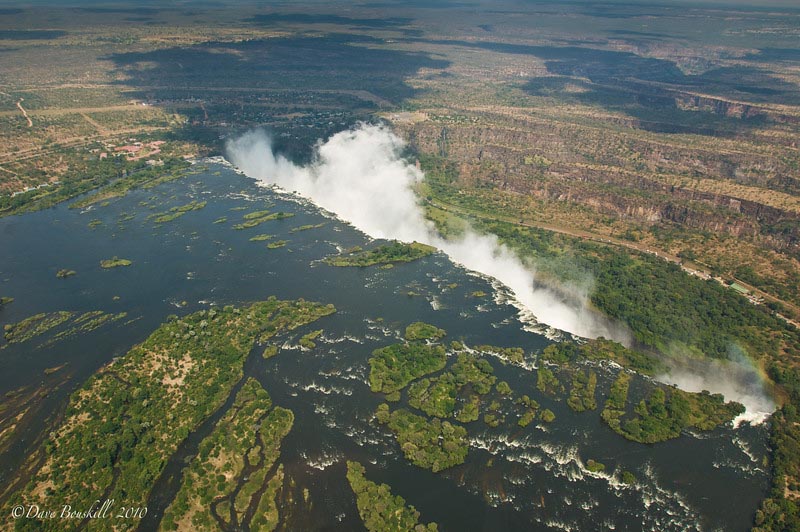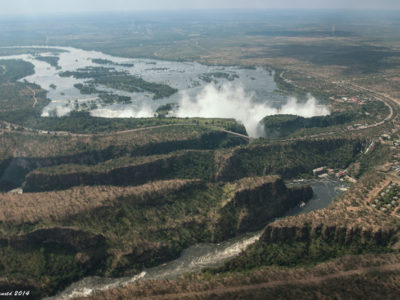The Smoke that Thunders is a suitable name for this impressive waterfall.
You can hear the roar from afar and feel the power when you are up close. Located in Livingstone, Zambia on the Zambezi River, Victoria Falls is one of the top sites to see in all of Africa.
The world’s largest waterfall by sheer volume, it dwarfs our beloved Niagara Falls in Canada.
Zambia, once known as Northern Rhodesia, is a former British colony and also the adventure capital of Africa!
This Zambia travel guide will help you plan your next vacation.
Table of contents
Table of Contents
Fast Facts about Zambia
- Zambia power voltage is 230V 50Hz; Plug C, D & G
- The Zambia currency is the Zambian kwacha and is around 5,000 ZMK to 1 USD
- Single and double entry visas can be obtained at the airport, border crossings or your local Zambian embassy. Multi-entry visas must be obtained in advance from an embassy.
- Beware of Chikungunya, a viral disease transmitted by the bite of infected mosquitoes. This outbreak continues to affect parts, Africa. Symptoms can take up to 12 days to appear but usually begin within 3-7 days after being bitten by an infected mosquito.
- Symptoms generally include fever and joint pain; other symptoms can include fatigue, headache, nausea, vomiting, muscle pain, and rash.
- Travelers spending a lot of time outdoors or visiting game parks have an increased risk of being bitten by a tsetse fly which can cause African Sleeping Sickness. Remember that these flies: bite during the day, are attracted to bright, dark colors and can bite through lightweight clothing.
- Camouflage or military clothing is not permitted so don’t pack it
- The water is not potable; drink only bottled water.
- SIM Cards can be bought in major cities. Airtel, MTN and Vodafone are the carriers and prices are very reasonable.
Things to See and Do in Zambia
- We spent 3 days at the falls in Livingstone and we filled it with not stop thrills from start to finish.
Dream Trip: Destination Victoria Falls - Go on a walking safari to South Luangwa, which is one of the best places in Africa to spot big game on foot
- Go Whitewater rafting on the Zambezi River
- Sit at Devil’s Pool on the top of Victoria Falls
- Take a microlight flight or helicopter tour over Victoria Falls
Budgeting
Accommodation
Budget: You can find a variety of hostels and budget hotels for 185-550 ZMW per night. Enjoy hot showers, dorms or private rooms, shared kitchens, and nearby restaurants and shopping areas. Staff can sometimes help you out with finding good deals on local safaris or for general travel advice.
Mid-Range: For mid-range hotels, expect to pay around 660-1,800 ZMW per night. Amenities include rooms with flat-screen TVs and tea/coffee facilities, an outdoor pool with a lounge area, free breakfast, and a hotel restaurant and bar.
High-End: For five-star hotels, you will pay around 2,000-3,300 ZMW per night. These hotels come with private suites with terraces and living rooms, spa services, an outdoor pool with a poolside bar, a fitness center, multiple hotel restaurants, a polished bar, and room service.
Food
Staples of Zambian cuisine include nshima (pounded white maize), vegetables, stews, fish, insects (especially caterpillars), and beer. Nshima is one of the most common items at any meal and is sometimes a meal itself with vegetables and meat or fish added to it. If you are near a market and want a treat, look for vitumbuwa (fried dough balls). Plan to spend around 160 ZMW per day on food.
The Best Ways to Get Around Zambia
Getting to Zambia:
Flights: The main airport to fly into is the Kenneth Kaunda International Airport, located 16 miles from the capital of Lusaka. Other airports include the Harry Mwanga Nkumbula International Airport in Livingstone, though it mainly takes African and British flights. You can check for the best flights to Zambia on Skyscanner.
Transportation:
Buses: Public buses are a cheap way to get around towns, though rides may be bumpy. Fares will cost about 40 ZMW. You can also look for private buses that go between major destinations (such as Lusaka to Livingstone for 120 ZMW) and are generally smoother rides. It is best to book at least one day in advance.
Taxis: Taxis are not metered, so make sure to check around to see what a fair price is. Licensed taxis will have the word “taxi” on the top of the vehicle with two stripes.
Car Rental: You might be able to find some cars, but driving is not as recommended if you do not know the roads. Many rental companies will not lend you a car if you do not have a chauffeur with you. It is best if you have transportation already provided for you, such as with a safari company. If you insist on a car, it can cost 4,750 ZMW per day.
Uber: There is no Uber, but there is Ulendo, a taxi app which operates similarly to Uber.
When to go To Zambia
The best time to go to Zambia is between the months of June and November. During this time, it is the dry season, temperatures are in the 80s to low 90s, and you have the best chance of seeing the most wildlife.
However, if you are an avid birdwatcher, March will give you great opportunities to see the most birds, though know that it is still the wet season.
Where to Stay in Zambia
Taj Pamodzi, Lusaka: Just a short trip to the Lusaka National Museum and the Kabwata Cultural Village, this is a great four-star hotel in Lusaka. Choose from a variety of rooms (standard rooms with flat-screen TVs and balconies to suites to whirlpool tubs and dining areas), and enjoy the numerous hotel amenities, including free breakfast, a squash court, a gym, an outdoor pool and hot tub, a hotel restaurant with a café and bar, a steam room, and a sauna.
Victoria Falls Waterfront: Stay just 5.5 miles from Victoria Falls at this hotel. Set on the Zambezi River, see the river from your hotel room while enjoying two outdoor pools, a riverside hotel and restaurant, a sauna, spa services, a fitness center, and a shuttle to Victoria Falls Airport.
Zikomo Safari Camp: If you’re heading to South Luangwa National Park, stay at this all-inclusive camp. Across the river from the National Park, stay in a chalet with a bathroom, electric fan, mosquito net, and a private deck. Activities include safari walks and tours of the South Luangwa National Park, as well as tours to the local village and nearby island.
Check out our favorite booking platforms Booking.com, Tripadvisor and VRBO for the best deals on accommodation.
What to Pack for Zambia
Zambia has a tropical climate modified by altitude (elevation).
It has a dry season from May to the end of October and a wet season from November to April.
During the wet season, some areas become inaccessible and many camps in Kafue, Lower Zambezi, and more remote parks are closed.
The dry season is divided into the cool dry season (May to August) and the hot dry season (September and October).
- Waterproof bag – the bag has two functions, protecting your stuff from the rain and also from the dust, especially if you’re traveling to drier regions.
- Footwear – especially important if going you are heading on a safari! Pack a pair of lightweight, durable, waterproof and comfortable shoes and also a pair of flip-flops or sandals that you can change into after a long day of sightseeing.
- Protection from the elements – pack sunscreen, sunglasses, a hat, a loose sarong or wrap to cover yourself from the sun and bug-spray to prevent getting bitten by a mosquito (that might have malaria!)
- Layers – pack the basic tropical clothes and make sure to include long pants, long-sleeve tops and some warm clothes for those chilly nights.
- Avoid packing dark colored clothes – tsetse flies are drawn to dark colors, like blue and black clothing, and their bite can give you African Sleeping Sickness. Stick to light, neutral colors but avoid packing white clothes as they will get dirty and dusty pretty quickly.
- Pack for Humidity – for humid weather it is best to pack fabrics that breathe as much as possible and natural fabrics, like cotton, linen or rayon (avoiding silk, wool and polyester). Clothing should be loose and comfortable to encourage the flow of air and allow moisture to evaporate
See our packing tips: packing list for smart travel.
See our packing tips: packing list for smart travel & How to Pack for a Safari
Zambia Travel Guide: Best Booking Resources
Whenever we travel to we make sure to start with these companies. We have tried a lot of different ones over the years and all of these have consistently proven to be the best when it comes to offering great prices.
We have used every one of these personally and continue to do so.
- Booking.com: This is our go site to when comparing prices for accommodation. It usually has the cheapest prices, especially in Europe and we love their interface. Not to mention you get free cancellation and you are guaranteed the best price.
- Trip Advisor: What we like about Trip Advisor is that we can look at all the reviews and then book our accommodation. TripAdvisor is where we go when we want to compare prices with multiple accommodation providers.
- VRBO: is the main search engine we use when we are looking for a home or apartment rental. It can sometimes be cheaper than hotels and it is the best way to stay in areas that offer a more local feel.
- Hostelworld: With one of the largest databases of hostels in the world, Hostelworld is the go-to site when you are looking for budget accommodation.
- Skyscanner: This is the first place we check for flights. It consistently comes back with the cheapest and best options. It allows us to compare a lot of airlines to get the best price.
- Rome 2 Rio: If you want to see how to get somewhere by plane, train, bus, ferry or car Rome2Rio lays it all out for you as well as related costs.I love how they show it all to you on a Google Map and it works offline.
- Get Your Guide: For all your day trip and city guide needs, we use Get Your Guide. It has the world’s largest collection of things to do with more than 30,000 activities in 7500 destinations.
- World Nomads Insurance: When traveling to Italy you should always have travel insurance. We have found the best bang for your buck is by far World Nomads.
Zambia Travel Guide: Related Articles
To browse all our articles and guides about Zambia click here.


